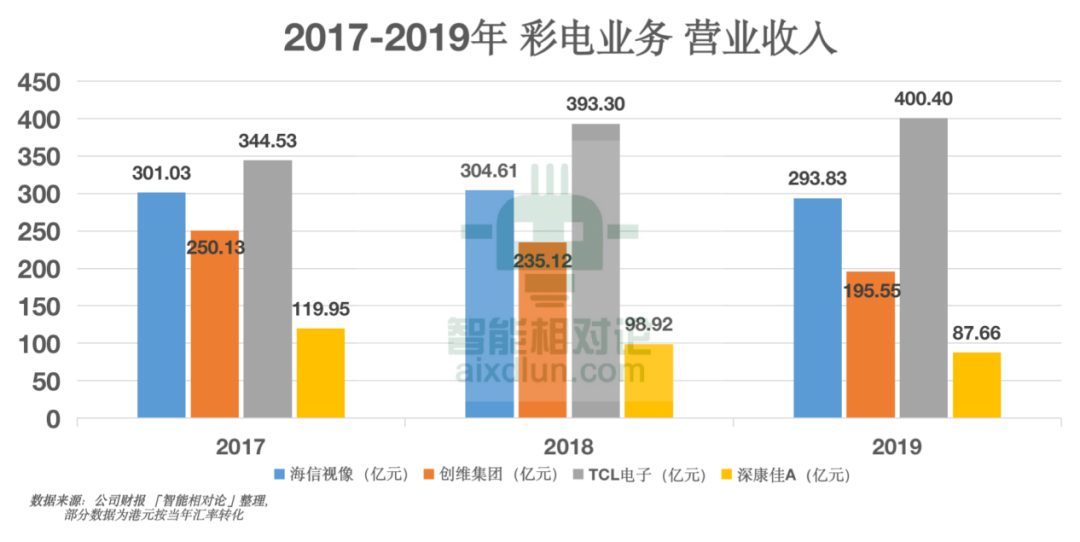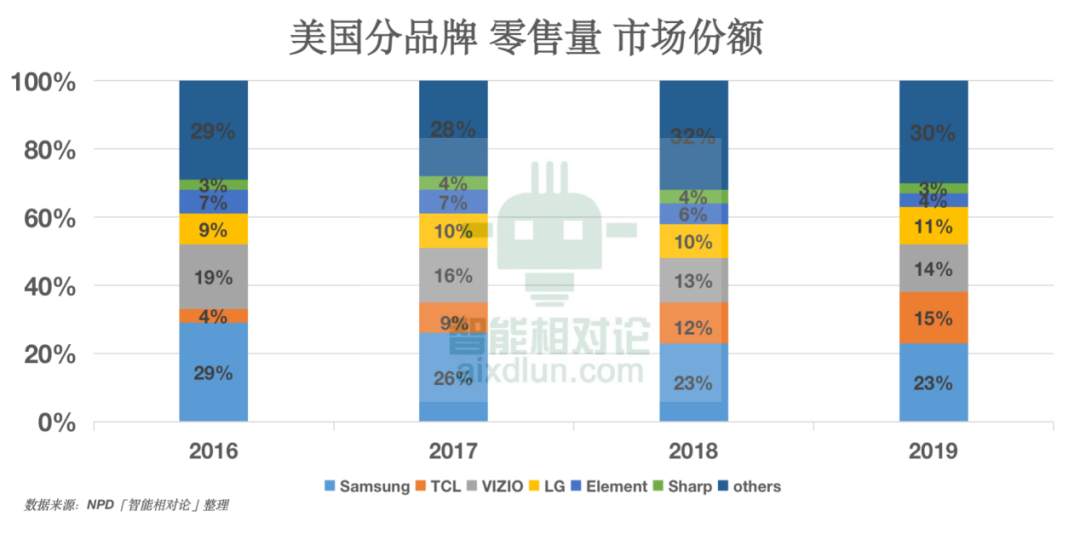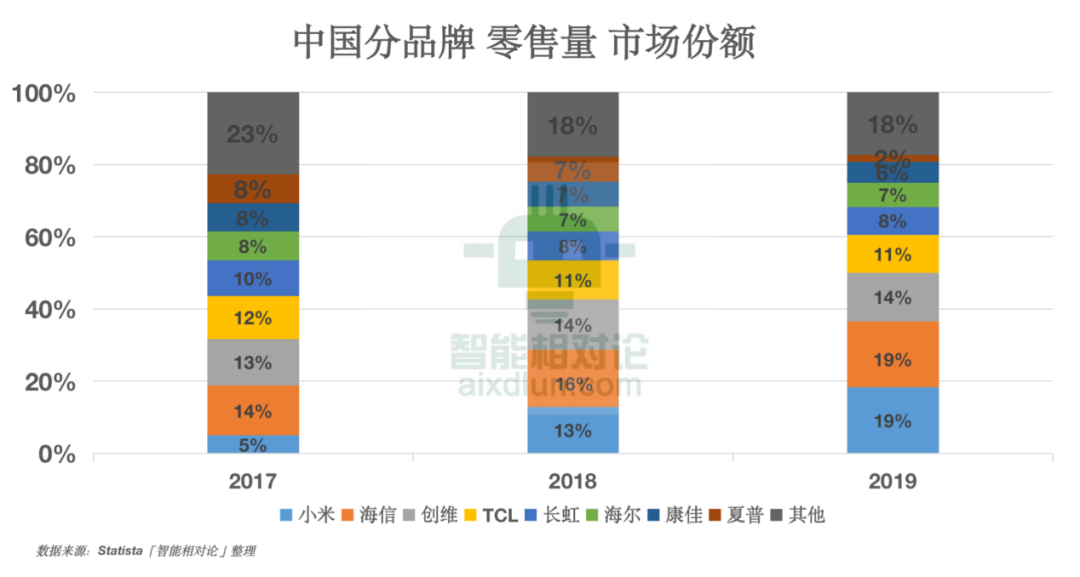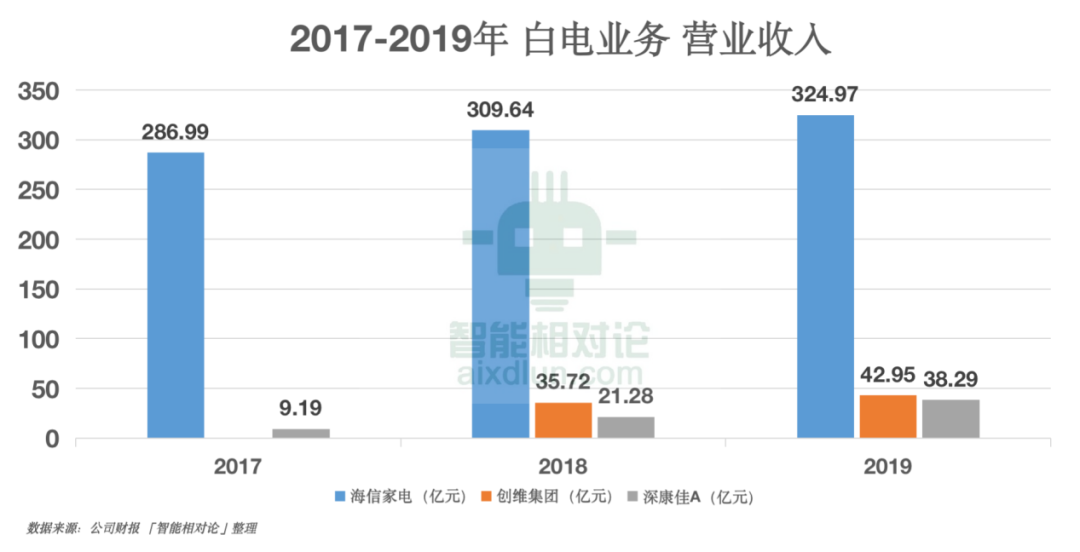Pioneering or Shoucheng, Konka, Skyworth, TCL, Hisense AB face big decryption.
Editor’s note: This article is from the micro-channel public number “smart relativity” (ID: aixdlun), Author: leo Chen.
The development of the industry is becoming more and more mature. When encountering the “black swan”, how to keep the foundation everlasting is a problem that must be faced.
Affected by the epidemic, in the past 2020, China’s home appliance industry has been under pressure to move forward. The home appliance industry, known as the “economic barometer”, has been superimposed on the influence of uncertain factors such as real estate regulation and control, and handed over a report card that is not ideal.
According to data from Aowei Cloud Network, the size of China’s home appliance retail market last year was 705.6 billion yuan, a year-on-year decrease of over 11%. In terms of breakdown, the decline rate of traditional home appliances is obvious. Air conditioners are followed by color TVs, kitchen appliances and ice washers.
For the color TV industry alone, despite the impact of the epidemic, the sluggish growth has certainly been an important factor that cannot be ignored. The industry has entered the era of stocks. The previous “price-for-quantity” strategy did not seem to work last year, and it has also fallen into the dilemma of upstream price increases.
The key to solving this inevitable problem for enterprises may lie in reflecting new value in the new historical period.
Challenges and opportunities coexist. During this period, the general environment is under pressure, forcing color TV brands to change. For example, brands such as Hisense, Skyworth, TCL, Konka, etc. have moved to the layout to seek breakthroughs. At present, opportunities are bred in the directions of going overseas, AIoT, and high-end.
From the starting point of 2021, “Intelligent Relativity” will combine years of financial data from the four traditional color TV brands of Hisense, Skyworth, TCL, and Konka, and look back at the highs and lows they have experienced. In addition, we will briefly discuss future possibilities around business outside of color TVs.
Looking back on 2020, TCL Electronics leads the way in gains and Hisense Vision takes the lead in market value
The color TV business behind the brands of Hisense, Skyworth, TCL, and Konka involves four companies. In the capital market, some companies are listed on A shares and some choose to list on Hong Kong stocks.
- The “Hisense Video” behind the Hisense brand was listed on the Shanghai Stock Exchange, which rose nearly 7% last year, and its current market value is 17.023 billion yuan;
- The “Skyworth Group” behind the Skyworth brand landed in Hong Kong stocks, which fell nearly 4% last year and its current market capitalization is HK$6.840 billion;
- The “TCL Electronics” behind the TCL brand landed in Hong Kong stocks, which rose by more than 66% last year, and its current market capitalization is HK$15.5 billion;
- The “Shen Konka A” behind the Konka brand was listed on the Shenzhen Stock Exchange. Last year, it rose by more than 52%, and its current market value is 14.809 billion yuan.
“Skyworth Group” and “Shen Kangjia A” operate a wide range of business, includingIncluding color TV, white TV and so on. “Hisense Video” and “tcl Electronics” are mainly color TV businesses and are listed separately as subsidiaries.
It is worth mentioning that Hisense’s white goods business belongs to “Hisense Home Appliances” and is listed in A+H; TCL’s white goods business is currently not listed.
Therefore, in a rough comparison, the stock price of “TCL Electronics” performed the best last year, while the market value of “Hisense Video” ranked first.
Returning to the financial report data, the “Intelligent Theory of Relativity” found that the basic results of several companies after the epidemic are as follows:
“Hisense Video” last year’s Q3 financial report showed that in the first three quarters, revenue was 27.480 billion yuan, a year-on-year increase of 16.23%; net profit attributable to shareholders of listed companies was 575 million yuan, a year-on-year increase of 117.42%.
The revenue of “Skyworth Group” in the first three quarters was 26.954 billion yuan, a year-on-year increase of 2.18%; total comprehensive income was 387 million yuan, a year-on-year decrease of 28.07%.
The revenue of “TCL Electronics” in the first three quarters was HK$31.833 billion, a year-on-year increase of 22.0%; net profit attributable to the parent after deduction from continuing operations was HK$811 million, a year-on-year increase of 56.6%;
In the first three quarters of “Shenzhen Konka A”, revenue was 29.801 billion yuan, a year-on-year decrease of 28.5%; net profit attributable to shareholders of listed companies was 615 million yuan, a year-on-year increase of 36.6%.
On the whole, revenue was mostly increased year-on-year, while net profit was mostly down year-on-year. But objectively, if the impact of the epidemic is removed, on the one hand, the situation of each company may be completely different, and on the other hand, it will better reflect the stage of the industry. The timeline stretched to a few years ago, how did they develop?
Color TVs are going down and “disrupting” continuously, and traditional color TV manufacturers are “under pressure”
Compared with the performance of the color TV business in recent years, the color TV revenue of “TCL Electronics” from 2017 to 2019 recorded approximately HK$408.2, 455.8, and 46.99 billion respectively. The amount hits a new high continuously, and the volume ranks first among the four companies.
The color TV revenue of “Hisense Video” recorded RMB 301.03, RMB 304.61, and RMB 29.383 billion respectively, and the overall performance was relatively stable.
The color TV revenue of “Skyworth Group” recorded 250.13, 23.512, and 19.55 billion yuan; Konka color TV revenues were respectively 119.95, 9.892, and 8.766 billion yuan. Unlike TCL and Hisense, Skyworth and Konka’s color TV revenues have shrunk continuously. Among them, Konka lags behind in the four brands.
The “Intelligent Theory of Relativity” found that TCL Electronics has been “out of the ordinary” in recent years, and its performance has risen against the trend, which is closely related to its global strategic layout. In 2020, overseas markets will account for more than 70% of sales. Mainly covering North America, Europe, and emerging markets including South America, Southeast Asia, Australia, etc., it has become an important driving force for the development of the company’s TV performance.
TCL’s market share in many overseas countries ranks among the top three. According to Qunzhi Consulting, the global market share of TCL brand TVs in the third quarter of 2020 reached 11.3%, ranking third. Analyzing the sales strategy, “Intelligent Relativity” found that its overseas market adheres to a cost-effective strategy to achieve a continuous increase in market share.
Industry insiders told “Intelligent Relativity” that in recent years, the average price of global TV sets has gradually declined. From a regional perspective, the average price of TV sets in the United States is higher than that in China, and the average price decline is lower than that in China. And this happens to help TCL’s cost-effective strategy to show its talents overseas.
Picture: Average TV price by region (unit: USD)
In addition, the company began to cooperate with Roku in 2014 to provide it with TV hardware, and Roku is responsible for providing content and operating platforms. In recent years, the number of active users of Roku has continued to grow, from 29 million in Q1 of 2019 to 40 million in Q1 of 2020. The Roku content platform has become more and more consumers’ choice, which to a certain extent promotes overseas sales of TCL TVs.rise.
In 2019, “Hisense Video” won the first place in China’s market sales, offline sales share, and the number of Internet TV users. Mastering the basic market of the domestic market is one of the important reasons for its stable performance for many years. .
From another perspective, it is an indisputable fact that the annual revenue growth of “Hisense Video” has been maintained at single digits. The first three quarters of 2019 showed a year-on-year decline of 2.91%. Revenue growth is getting weaker, on the one hand due to the unsatisfactory expansion of overseas markets, on the other hand, it is related to the poor domestic environment.
In 2017, “Hisense Video” acquired Toshiba and tried to enter the international market, but the problem of sales channels has not yet been completely resolved. This has caused it to remain at a loss, and ultimately drag down the overall color TV business.
The weak domestic TV market demand has led to competition in inventory and price wars becoming more apparent. The top brands represented by Hisense have fought a price war. Although it has promoted the increase in market share, it is still difficult to reverse the overall decline in color TV sales.
Hisense, which has a variety of first auras, is still the case, Skyworth and Konka are not spared, and the revenue of the color TV business is in the dilemma of stagnant growth.
The “Smart Relativity” reminds us that what we need to pay attention to is that a number of mobile phone manufacturers and Internet manufacturers have joined the smart TV track one after another, which has caused a greater impact on traditional TV manufacturers.
In the domestic TV market, LeTV is an inevitable pioneer. Although LeTV collapsed and left a lot of feathers, it was once regarded as a disruptor of the industry under the banner of “new business model”. Low-price and high-end are LeEco’s labels, and only use one-third of the price of traditional manufacturers to conquer the city.
After LeTV, Xiaomi is the first person to eat crabs in the true sense. Different from the lack of TV intelligence during the LeTV era, Xiaomi focuses on smart home and AI intelligent interaction, and it has risen strongly in a short period of time at an ultra-low price, achieving a significant market share.
“There are few winners among the Internet companies that have entered the game, but the threat cannot be ignored,” an industry insider told the “Intelligent Theory of Relativity.” “The growing share of Xiaomi TV has a profound impact on the industry and directly affects the prices of some mainstream size products.”
“In the past, this created a psychology for consumers to hold money for purchase, and at the same time put the problem of business model transformation in front of traditional manufacturers”, industry insiders added.
There are many new entrants, more based on AIoThe overall layout of the T smart ecosystem is considered strategically. In fact, traditional manufacturers such as TCL, Hisense, Skyworth, and Konka have the capital to parry.
As far as competition in a single TV category is concerned, these new players do not yet have differentiated technical capabilities. It is more to copy and imitate traditional TV companies, coupled with factors such as manufacturing, supply chain, channel capacity shortcomings, and solid brand impressions, it is actually difficult for them to surpass traditional TV brands. Moreover, traditional manufacturers have already made product changes based on Internet thinking.
Traditional color TV brand “Middle-aged re-employment”, “change to white TV” under the name of AIoT
Only relying on the TV business, the future growth space is getting smaller and smaller, which has almost become the consensus of the entire TV industry. And diversification has become a cure for increasing valuation and enhancing one’s own imagination.
A few years ago, when LeTV, Lenovo, Xiaomi and others rushed to compete for the market share of smart TVs in the black market, Skyworth, Hisense, TCL, and Konka began to extend their tentacles to the white goods fields of refrigerators, washing machines, and air conditioners. TCL did not disclose the specific data of the white goods business. The basic information of the remaining three brands is as follows:
- The annual report of “Hisense Home Appliances” shows that the revenue of white appliances (ice washing and air-conditioning) from 2017 to 2019 was 286.99, 30.964, and 32.497 billion yuan, respectively, maintaining growth for three consecutive years;
- The annual report of “Skyworth Group” shows that the revenue of white goods business in 2018 and 2019 was 3.572 billion and 4.295 billion yuan respectively;
- The annual report of “Shenzhen Konka A” shows that the revenue of white goods business from 2017 to 2019 was 9.19, 2.28, and 3.829 billion yuan, respectively.
On the whole, the data growth in recent years has been good, which at least shows that the diversified layout has been effective. Among them, Hisense’s white power industry is the largest and most mature.
Konka black power does not “bright” white power “bright”, white power has achieved growth against the trend. The reason for this is related to its acquisition of Xinfei and its strengthening of the white goods business. After completing the acquisition of Xinfei, a series of actions were taken to accelerate cultural integration and strategic matching, including the replacement of Xinfei’s original leadership, promoting Xinfei to improve its product structure, adjusting and optimizing channels, etc.
At present, downward pressure on the TV industry is increasing, and cross-industry competitors are increasing. Choosing to promote the development of white goods smart business is conducive to the implementation of the diversification strategy of TV companies and balances business risks. And white electricityCompared with the TV business, the business has a higher profit margin, which is conducive to the overall improvement of profitability.
Some professionals have told the “Intelligent Relativity” that black power companies have to step up their efforts to develop white power businesses with considerations from the perspective of AIoT. This can help companies keep up with the new frontiers of the smart home industry, combat the intelligent collaborative development of all categories, and provide users with upgraded smart services.
However, just like the color TV industry has barriers to competition, the white TV industry has low barriers to entry, but high barriers to competition. At present, the three giants of white appliances are far ahead with an absolute advantage of scale.
The market value of Midea Group exceeds 650 billion yuan, Gree Group exceeds 300 billion yuan, and Haier Zhijia exceeds 270 billion yuan. Behind them is Hisense Appliances, which ranks fourth.
The main categories of white appliances are guarded by giants: the gap between Midea and Gree air conditioners and the brands behind them is gradually widening; Haier refrigerators are far ahead, followed by Midea, Rongsheng, Siemens, and washing machines. Swans occupy most of the market. Therefore, it is difficult for new forces to break out in the short term.
Conclusion
In terms of diversified layout, the choice of traditional TV brands is not limited to the white goods business.
Skyworth has formed four major businesses: multimedia, smart appliances, smart system technology, and modern service industry; Konka has entered the fields of environmental protection, new materials and semiconductors through strategic investment and joint ventures; similar to the first two , TCL also regards semiconductors as the focus of business development.
The home appliance market is sluggish and growth prospects are limited. Traditional TV brands choose to shift from labor-intensive to technology-intensive industries to find new engines to empower the industry.
Back to the black and white power business, traditional TV brands will not let them “do it alone.” Major TV brands are currently focusing on smart TVs, connecting white appliances and kitchen appliances in series to build an AIoT ecosystem.
In this ecology, smart screens, large-screen products, and diversified display technologies have become keywords in the color TV industry, helping companies enter the era of smart homes steadily. In the future, companies must overcome numerous problems in multi-screen, smart interaction, and IoT control, or can truly bring users back to the living room.
There is still a sea of stars in the home appliance market, and companies still need to accumulate energy now.
The pictures in this article are all from the Internet
This content is the original [Intelligent Theory of Relativity] and only represents personal views. Without authorization, no one may use it in any way, including reprinting, extracting, copying, or creating mirror images.





